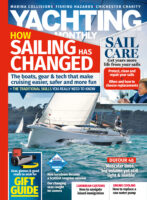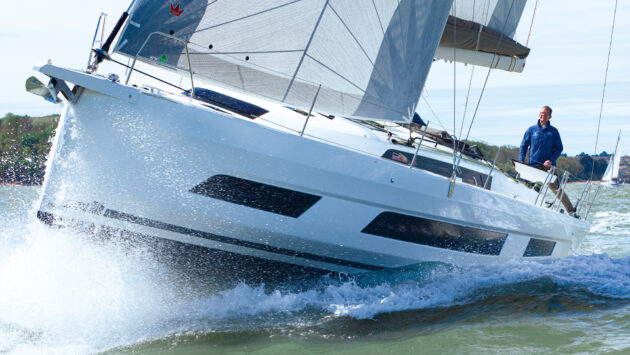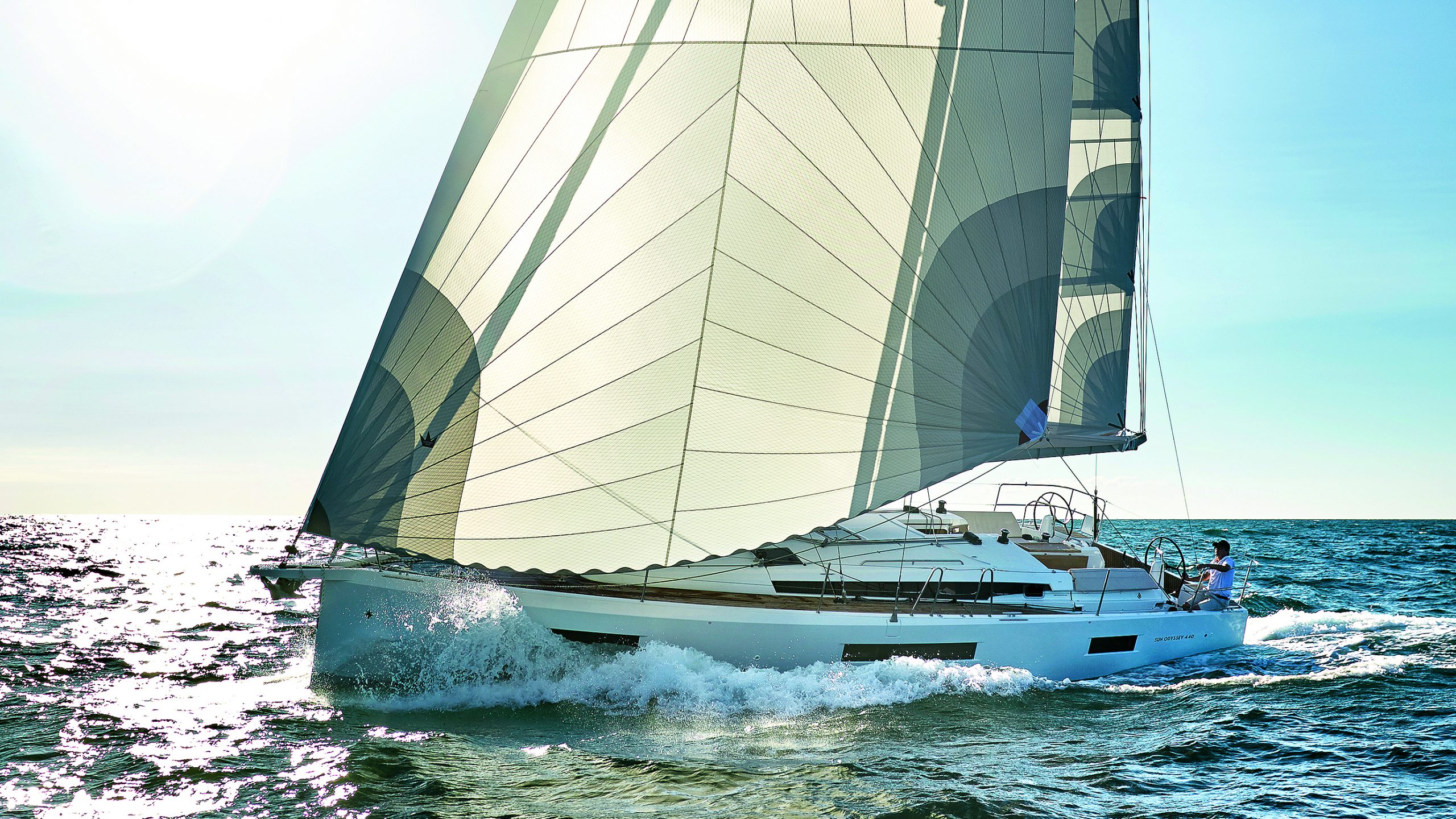Most online pundits are wrong and you don’t need a long keel to go offshore, reckons Mike Morgan, who makes the case for modern production yachts
As an addict of YouTube sailing channels, I am surprised at the amount of misinformation surrounding the ocean capabilities of modern boat design compared to the boats of a generation ago. There seems to be a strong dislike from a large part of this community against production boats, typically from manufacturers like Beneteau, Jeanneau, Hanse and Bavaria.
Their argument seems to come from their belief that the only boat capable of offshore passage making or ocean crossing must have a heavy displacement, raked bow, a narrow beam, a deep underwater profile, an encapsulated keel moulded as part of the hull, with a keel-stepped mast and a single skeg hung rudder.
Indeed many ‘influencers’ suggest production boats are not fit for offshore passages or crossing oceans and are only capable of coastal cruising. Don’t get me wrong, many of their go-to choices are brilliant boats for crossing oceans, but my point is that modern boats are too.
I should confess at this point that I have yet to cross an ocean but I have over 10,000 sea miles under my belt and have undertaken a 10-day passage from the UK to Gibraltar with a ‘lively’ Biscay crossing. As an owner of one of these ‘production boats’ – a Bavaria C57 – I wanted to address some of these myths and argue the case for the modern boat’s offshore passage making capability.
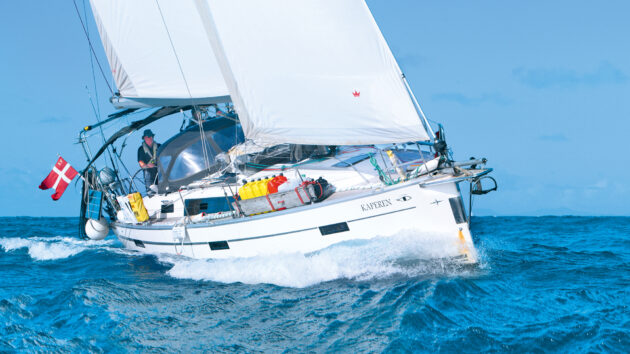
Bavaria Cruiser 37 Kaparen, owned by Karsten Pedersen, completes the ARC, proving among many others that production boats are up to ocean crossings. Photo: WCC/Tim Wright/Photoaction
Firstly, many modern production boats have crossed oceans and completed circumnavigations, which immediately debunks critics’ assertions. As they say, the proof is in the pudding. While the recent Golden Globe Races stipulated boats of a certain era, the parallel Longue Route event had a far more diverse range of more modern boats, many of which were just as, if not more, successful than the older boats.
In praise of production yachts
Often the hull construction process and strength are cause for concern, citing hull thickness in the hand layup process is far better and stronger than vacuum infusion hulls. This is a myth. Vacuum infusion for hull layup is now a widespread method for hull construction amongst boat builders both from the high-end and production brands alike.
This is not a cost-saving exercise but a technique to have no air in the layup process, making for a stronger, stiffer and lighter hull. Vacuum infusion is arguably stronger than hand laid-up hulls due to better resin and fibre ratios which are achieved through the process. It is lighter and produces a faster boat.
Article continues below…
How hull shape affects comfort at sea
Understanding how your hull shape responds to waves will keep you and your crew safe and comfortable in a blow,…
Busting the hull speed myth
Waterline length is not the defining factor in maximum boat speed that we all think it is. Julian Wolfram busts…
Influencers show damaged production boats that have been hit by other vessels as if to provide proof that hand laid-up hulls are stronger. A friend of mine was recently hit by a fishing boat whilst at anchor on his 20-year-old Beneteau 57, which was their top end luxury cruiser built in the Noughties designed to compete with the likes of Hallberg-Rassy, Amel and Oyster. The ‘hand laid’ hull was completely stove in, luckily above the waterline.
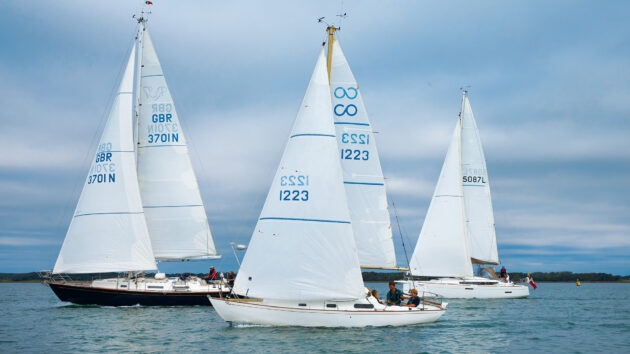
Each of these boats has a different hull form, keel type and rudder arrangement. Photo: Graham Snook
Hull shape
One complaint with modern hull forms and their plumb bows, shallow entry and wide sterns, is that they pound when sailing close hauled. I do agree that if you sail directly into the waves and dependent on their height, timing and spacing, some boats of the last 20 years will slam, particularly where they have shallow, flat sections in the forefoot.
I would argue, however, that all boats will slam in certain conditions, and older boats with V-shaped bows are more prone to slamming at certain angles of heel. Indeed many of the latest boats built for offshore sailing have deep, rounded sections at the bow that are much better at preventing slamming at all points of heel.
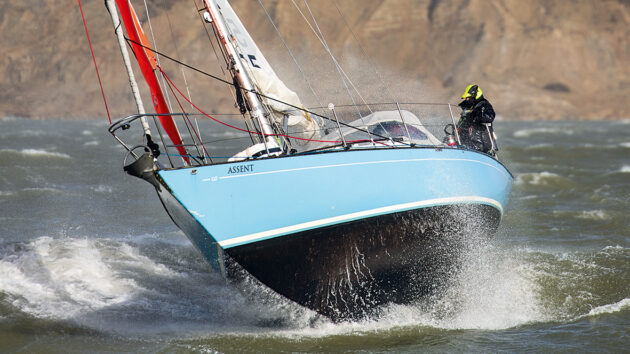
V-shaped hulls can present large flat surfaces to the sea when heeled. Photo: Richard Langdon
For coastal sailing, reliable weather forecasts make it a fairly rare occurrence that we are caught out by unexpected sea conditions. If I do get caught out, I approach the waves at an angle or turn around and go on a run until the storm has passed. Another major advantage of modern boats is that they tend to have superior speed due to their weight and hull form. This enables you to avoid storms or squalls or reduce the time you are in one.
While deep, narrow hulls are generally better upwind, they can be different beasts downwind. Narrow sterns in particular provide little form stability, leading to the nauseating rolling associated with tradewind sailing.
Most ocean crossing routes that cruisers and circumnavigators undertake predominantly follow the trades, with the breeze on or abaft the beam. Modern, beamy boats have far more form stability with much less tendency to roll, and a greater ability to exceed hull speed in a controlled manner, making tradewind ocean crossings far more comfortable.
Rudders
Then there is the topic of rudders, around which misinformation abounds. The claim is that to be a true ocean-going vessel you need a single skeg-hung rudder. I have heard it argued that twin rudders are only used because they are easier and cheaper to install than a skeg and rudder. That’s clearly wrong, given that two of everything has to be reinforced and installed.

Twin rudders ensure that one rudder is always vertical and fully submerged. Photo: Paul Wyeth
Twin rudders are designed specifically to accommodate the beam of the boat when heeling. On a single rudder boat when beating to windward, the rudder will be at an angle, making it less effective at steering, and subject to both aeration from the surface and stresses you would not get on a twin rudder boat as the angle of heel would keep one of the rudders vertical and fully submerged, offering far more grip and directional stability. While
a wide hull shape will become more asymmetrical once heeled, it’s not true that they develop more weather helm.
When it comes to rudder stocks, there is debate about whether stainless steel or aluminium is the correct material to use, with traditionalists clinging to stainless as a stronger material were you to go aground or hit a container. Jefa, one of the largest manufacturers of rudders, supply both materials, but state emphatically that ‘stainless steel 316 rudder shafts are NOT stronger than aluminium 6082 rudder stocks.’
After being attacked by orcas a couple of years ago, I can testify to the strength of my twin Jefa aluminium rudder stocks.
While we were getting repairs in La Linea boatyard, there were several boats which had to be towed in after a visit from our aquatic friends, all of which had skeg-hung rudders and had lost all their rudder and in one instance had bent the stainless steel rudder stock.
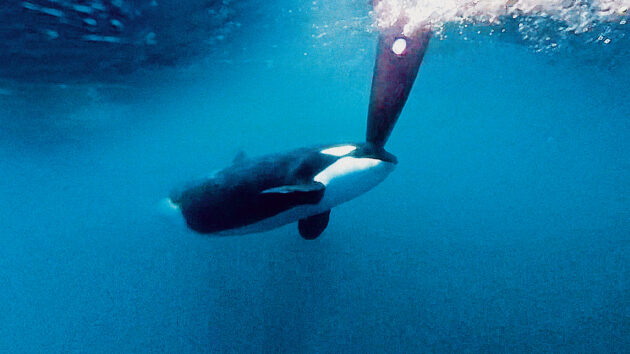
Iberian orcas show no mercy when it comes to rudders. Photo: Brend Schuil / Team JAJO / The Ocean Race
Though I needed repairs, my boat hadn’t been disabled thanks to the bottom couple of feet of the rudder blades being sacrificial. The orcas clearly enjoyed chewing them, but left the upper portions of the rudders intact where they were reinforced with aluminium, leaving me with functioning steering.
Corrosion can be an issue with aluminium, but if there is a problem, you’ll be able to see it. Stainless steel is prone to crevice corrosion, especially where water becomes trapped next to it, yet it is exceedingly difficult to spot and diagnose from a visual inspection. This can cause sudden and catastrophic failures, which is why insurers insist on us all changing our stainless standing rigging so often.

Handling a twin rudder boat at close quarters requires different skills to long-keeled boats. Photo: Graham Snook
Pros and cons of twin rudders
By default, a twin rudder setup builds in redundancy. Some boats are able to decouple their rudders and operate them independently if either of them becomes damaged. What happens when your only rudder or steering is damaged? The risk of losing a single rudder led the organisers of the Golden Globe Race to stipulate additional emergency steering rudders should boats lose their rudder, or control of it.
It’s true that in close quarters manoeuvring, twin rudder boats do not have the advantage of prop wash over the rudder to assist low speed manoeuvrability.
Keep some way on, however, and twin rudders offer incredible grip and control.
The skills for mooring these different vessels is subtly different, and you need to keep making way until you have berthed, unless of course, as many new boats do, you have the option of both bow and stern thrusters, making them far more manoeuvrable than any long-keeled boat with an offset prop trying to go astern.
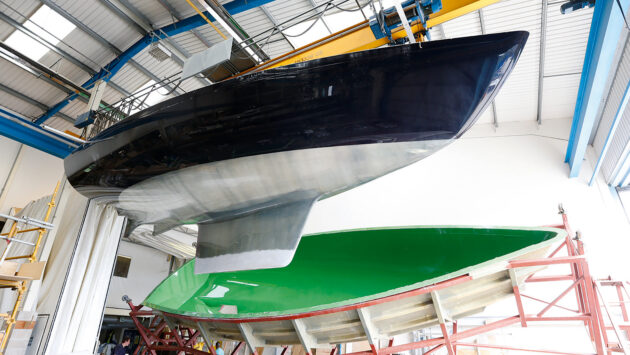
Rustler still builds yachts with encapsulated keels. Photo: Rustler/Graham Snook
Keel failure
Now we come to the question of keels. Clearly, a number of high profile events have been covered in the media and highlighted the problem of keel failure. But it is a myth that you need a long or encapsulated keel for ocean sailing due to the risk of external fin keels failing.
Statistically I am sure they could prove that more bolt-on fin keels fail than other types, but this is simply because there are far more of them.
Most keel failures result from hard groundings that have not been surveyed and repaired, or repaired poorly. Encapsulated keels are not without their own problems around water ingress into the ballast cavity, and external ballast on long keels can also fail.
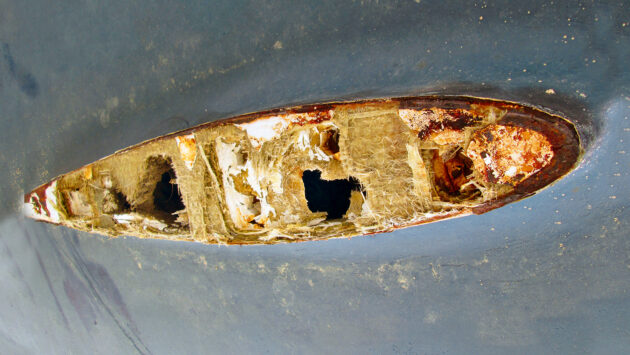
Delaminating or sodden fibreglass can lead to failure of any kind of keel. Photo: Ben Sutcliffe-Davies
Bluewater designs
Most traditional ‘bluewater’ brands from Scandinavia and around the world, including Hallberg-Rassy and Oyster, now choose to opt for wide beams, bolt-on keels and twin rudder designs, which speaks volumes.
The new Oyster 565, which is similar in size to my vessel, has twin rudders, bolt-on keel and a beam of over 5m. Is this Oyster then by default not a bluewater cruiser? I think Oyster may have something to say about that.
Older boats will, simply by their age, have more likelihood of problems and subsequent fatigue or corrosion of the keel bolts. I have also read that fully encapsulated keels also have their fair share of problems once the inevitable bilge water gets in and does its corrosive work.
Speaking to a surveyor, the one thing that does make a difference that is more expensive to build and which is omitted from most production boats, is the moulding of a keel stub to which the keel is bolted.
This is much stronger than a standard rounded or flat hull, as the additional curves of a stub reinforce this part of the hull.

Some production boats could be accused of skimping on the number, quality or size of deck fittings such as winches. Photo: David Harding
Deck Gear
Critics of modern production boats say that deck gear and other hardware is not up to scratch and poorly specified. This is nonsense. Most deck hardware comes from the same manufacturers be it on a £1m boat or a £100,000 boat.
I’m not going to deny there aren’t times when a winch could be a size or two larger, or mainsheets and backstays have a smidgeon more purchase, but much of this will depend on the kind of sailing you do. Of course, if you’re heading to exposed areas with little shelter, then it’s only sensible to make sure your boat is properly equipped and specced for that kind of sailing.
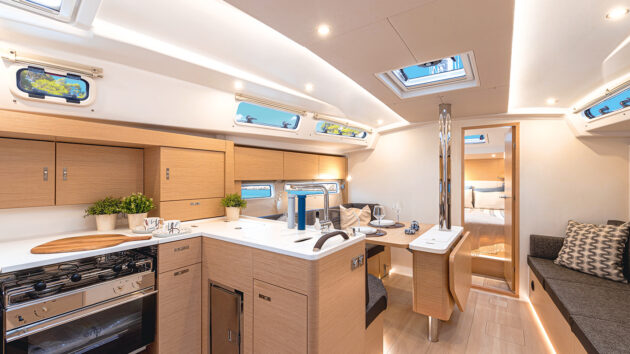
Production boats have light and modern interior design. Photo: Hanse
Joinery
The quality of the joinery and fit out down below is often thought of as more basic, and ‘flat-pack’ on production cruisers, the suggestion being that they are simply trying to stay on trend at the cost of quality.
To my mind, the affection for acres of dark mahogany, steep companionway ladders, cramped interiors and little natural light is just perverse. This is my home from home, so why not have all the same conveniences?
Would you buy a Victorian terraced house that has not been updated since it was built over a modern apartment with all mod cons? I guess some might.
Critics of modern production boats say that deck gear and other hardware is not up to scratch and poorly specified. This is nonsense. Most deck hardware comes from the same manufacturers be it on a £1m boat or a £100,000 boat.
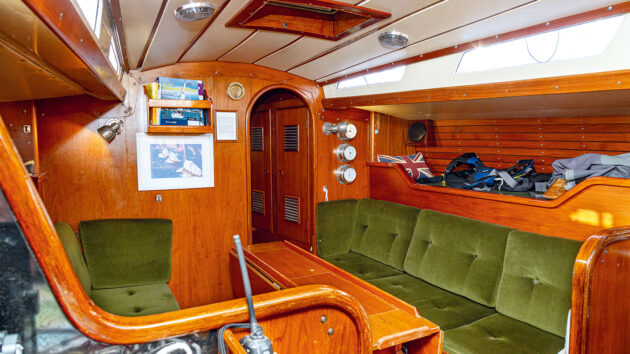
Older boats’ interiors tend to be much darker and more confined. Photo: David Harding
I’m not going to deny there aren’t times when a winch could be a size or two larger, or mainsheets and backstays have a smidgeon more purchase, but much of this will depend on the kind of sailing you do. Of course, if you’re heading to exposed areas with little shelter, then it’s only sensible to make sure your boat is properly equipped and specced for that kind of sailing.
Time at anchor
Lastly, most long sailing passages end with time at anchor. I estimate that last season, sailing some 2,000 miles around the Mediterranean, we were at anchor 90% of the time. What boat would you pick coming into a sweltering anchorage after a long passage; a narrow double ender with tiny cockpit or an airy modern yacht with a large social area, drop down swimming platform and BBQ?
The European Union created a Recreational Craft Directive that established design standards for recreational boats from 2.5 to 24m (8 to 79ft). The further offshore the vessel is expected to venture, the higher the expectations are for construction strength, stability, freeboard, reserve buoyancy, resistance to down flooding, deck drainage and other seaworthiness criteria.
Category A is ocean-going and covers self-sufficient boats designed for extended voyages with winds of over Beaufort Force 8 (over 40 knots), and significant wave heights above 13ft, excluding abnormal conditions such as hurricanes. All modern sailing boats built after 1998 will have a rating. I would prefer to rely on this standard than the opinion of a YouTube sailor whose boat has no formal classification other than their opinions.
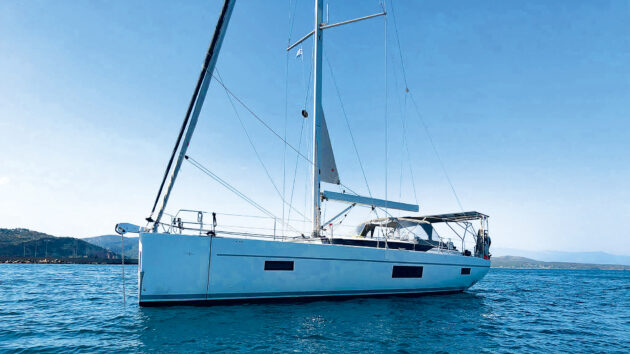
Most cruisers will spend the majority of their time in harbour or at anchor, even when on long cruises. Photo: Mike Morgan
I find it troubling that these influencers who are educating thousands of new would-be sailors are misleading their audience about modern production boats. The praise that is heaped on them as seen from the comments worries me. They are perceived as experts and there is no way to challenge their assumptions or assertions.
Buying a 20- or 30-year-old boat due to these influencers’ opinion of what they think a bluewater boat must have and dismissing modern boats as coastal cruisers, will lead many to making a poor purchasing decision. Older boats, because of their age, will come with a host of problems, from leaking windows and ageing deck fixtures to more serious structural issues. This will not be the case for a more modern boat, at least not for now.
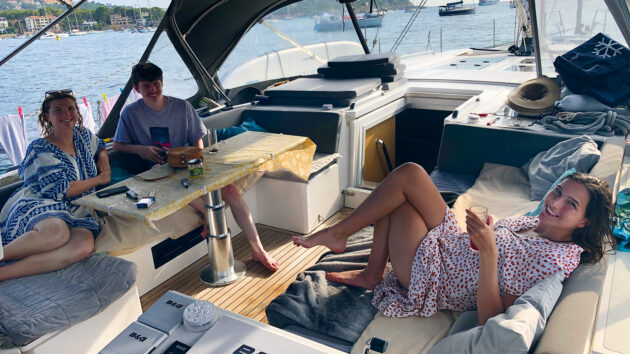
Mike and his family love having space to relax in comfort on deck. Photo: Mike Morgan
Embrace the future
The views which are widely shared on these channels come from a community which has yet to accept that boat design has changed forever and will continue to evolve for the better. I am certain naval architects are not designing Category A sailing yachts for coastal cruising. They are designing vessels from an offshore perspective and take into account the safety of the boat and crew when penning the next generation of yachts.
I liken these influencers’ dislike for modern boats to those who hang on to paper charts as their primary source of navigation when you have so much now electronically. Both Imray and the Admiralty (UKHO) had plans to end paper chart publication as demand has dwindled, but loud protests mean they have been continued for now.
We must embrace the future and not hang on to the past.
Enjoyed reading this?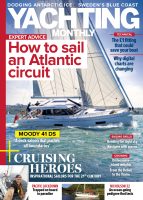
A subscription to Yachting Monthly magazine costs around 40% less than the cover price, so you can save money compared to buying single issues.
Print and digital editions are available through Magazines Direct – where you can also find the latest deals.
YM is packed with information to help you get the most from your time on the water.
-
-
- Take your seamanship to the next level with tips, advice and skills from our experts
- Impartial in-depth reviews of the latest yachts and equipment
- Cruising guides to help you reach those dream destinations
-
Follow us on Facebook, Twitter and Instagram.
Note: We may earn a commission when you buy through links on our site, at no extra cost to you. This doesn’t affect our editorial independence.

